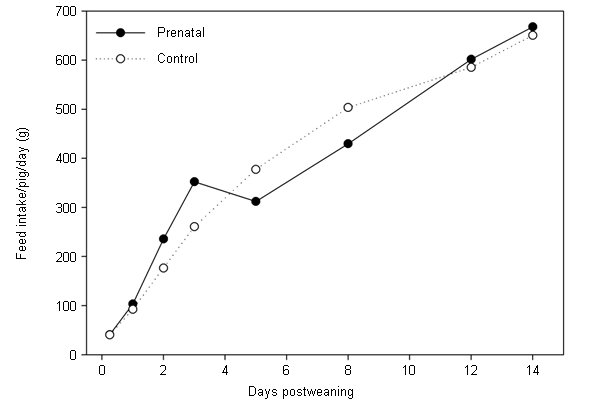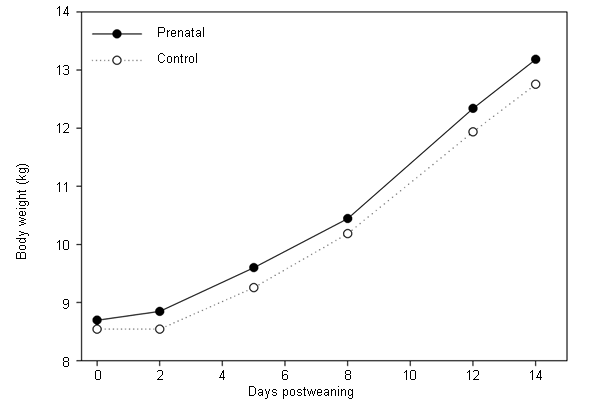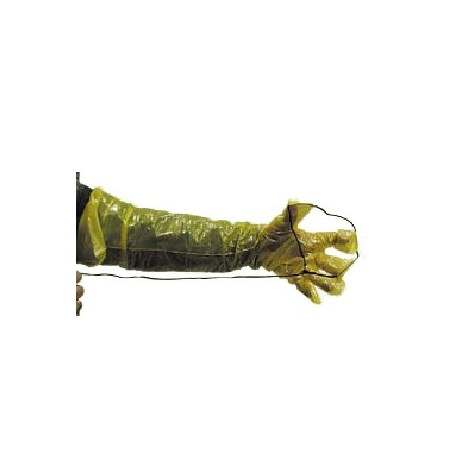Introduction
Piglets in commercial husbandry are generally weaned between 3 and 4 weeks of age, which is earlier and more abruptly than would occur in the wild. As a result, many piglets have not had experience with solid food before weaning, resulting in a low food intake and poor growth in the immediate post-weaning period. Newly weaned piglets also often show a high incidence of diarrhoea and maladaptive behaviours after weaning, partly due to the low feed intake and subsequent overfeeding, but also due to high levels of weaning stress. Providing piglets with more opportunities to learn from their mother about what, how and where to eat can potentially increase food intake before and after weaning and consequently reduce health and welfare problems after weaning. One such way of learning is through flavours from the maternal diet, in utero and through the milk: perinatal flavour learning. Perinatal flavour learning has been shown in a wide variety of species including humans, and often results in a preference in the offspring for a flavour that the mother ate often during late gestation and lactation.

Perinatal flavour learning in pigs as a tool to increase food intake?
In the first experiment on perinatal flavour learning in pigs, piglets were exposed through the maternal diet either prenatally (flavour in sow’s diet from day 98-108 of gestation), postnatally (flavour in sow’s diet from day 6-24 of lactation), perinatally (i.e. flavour in sow’s diet both during gestation and lactation), or never. The model flavour that was used was anethol, the molecule responsible for anise flavour. After weaning piglets were fed a commercial creep feed in two feeders: one with addition of anethol and one without. Prenatal exposure of piglets to anisic flavour through the maternal diet significantly increased food intake and body weight after weaning, particularly in the first few postweaning days (Figure 1 and 2). Prenatal exposure also significantly reduced diarrhoea prevalence (1.9 days versus 2.8 days) and damaging behaviours, such as belly nosing, tail and ear biting. The results indicate that particularly prenatal flavour learning can be used as a tool in piglets to improve postweaning performance, health and welfare.
Postweaning feed intake

Figure 1. Feed intake per piglet per day in the first 14 days after weaning. The black dots indicate the feed intake of piglets exposed to the flavour prenatally (prenatal + perinatal treatments). The white dots indicate the feed intake of piglets not exposed to the flavour prenatally (postnatal + control treatments).
Postweaning body weight

Figure 2. Body weight of piglets over the first 14 days after weaning. The black dots indicate the body weight of piglets exposed to the flavour prenatally (prenatal + perinatal treatments). The white dots indicate the body weight of piglets not exposed to the flavour prenatally (postnatal + control treatments).
Preference versus stress
The piglets in the first experiment did, however, not show a preference for the flavour to which they were exposed. They ingested more of the non-flavoured creep feed. This led to the idea that possibly the prenatally exposed piglets did not just eat more because they recognized and/or preferred the flavour in one of the creep feeds offered. Rather, the familiarity of the flavour that was present in the postweaning environment may have reduced weaning stress and made the piglets less reluctant to start eating after weaning.
This idea was confirmed in the second experiment. In this experiment, piglets that were exposed to the flavour through the maternal diet both before and after birth, or never, were provided with the anise flavour in the feed, or only in the environment (i.e. in the air) after weaning. Again, the piglets that had previously been exposed to the flavour showed a significantly higher performance after weaning (Table 1) and showed lower levels of stress indicators such as salivary cortisol and maladaptive behaviours. It did not matter, however, whether the flavour was present in the feed or only in the environment. This indicates that perinatal flavour learning can result in a reduction of weaning stress, which in turn increases performance of newly weaned piglets.
Table 1. Latency to eat and within-pen variation in growth in the first 14 days after weaning.
| Perinatally exposed | Control | |
| Latency to eat (min) | 23.9 | 34.3 |
| Within-pen variation growth (kg) | 0.69 | 1.08 |
| Pigs losing weight in first 3d (%)* | 11.5 | 21.9 |
*Not statistically significant





